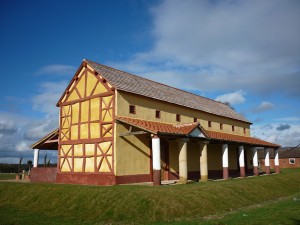 Construction experts have built a Roman town house in Wroxeter Roman City in the British county of Shropshire using only traditional Roman tools, techniques and materials.
Construction experts have built a Roman town house in Wroxeter Roman City in the British county of Shropshire using only traditional Roman tools, techniques and materials.
The house was designed by archaeologist Professor Dai Morgan Evans and took six months to build. The construction was filmed for a Channel Four series called Rome Wasn’t Built in a Day (which you can watch online if you’re in the UK or using a proxy).
It took a team of seven builders six months, 150 tonnes of sandstone bricks, 15 tonnes of lime mortar and 26 tonnes of plaster – all mixed by hand – 1,500 hand-cut timber joints and 2,600 hand-cut roof tiles to create the house, based on a real building excavated at Wroxeter, which was once the fourth largest city in Roman Britain and is now an archaeology visitor attraction in the care of English Heritage.
The workers, more used to plasterboard and plastic windows, had no experience of traditional techniques. A Channel 4 series, Rome Wasn’t Built In A Day, tracked their steep learning curve – and the running battle of the wheelbarrow.
The builders were incredulous when Evans insisted that, however advanced their plumbing and road-building, the Romans had no wheelbarrows, so everything had to be carried on to the site by hand. The builders kept smuggling in wheelbarrows; he kept throwing them out. When the roof boards were on, they wrote in giant letters “Romans had wheelbarrows” – now covered by the shingles.
“They absolutely did not have wheelbarrows,” Evans said. “I’ve done a lot of work on this now. They had wheelbarrows in China, but there is no record, drawing or evidence for a wheelbarrow anywhere in the Roman empire. The first reference I can find is Isidore of Seville, and that’s in the seventh century – centuries after our house.”
Think of all the massive construction projects all over the empire built with materials carried in baskets or one brick at a time. The mind boggles.
The town house includes servants’ quarters, small, dark, depressing bedrooms, and baths heated with the Roman hypocaust system of underfloor heating where a wood-burning furnace heated empty space left under the floors and inside the walls. This wouldn’t have been used to heat the living quarters, though. That job was left to coal braziers, but when Evans’ team tried it they had to douse the fires after just an hour because the carbon monoxide sensors were freaking out.
There were a few other concessions made to modern sensibilities, like fire exits and wheelchair-accessible pathways. The builders also left one room unfinished so visitors can see the process of construction. One wall shows in different sections bare stonework at the base, then wooden posts joined horizontally, and lastly the wattle and daub filling inside the wooden frame to create a solid wall.
The house officially opened to the public yesterday. For those of us not fortunate enough to visit in person, there’s a neat virtual tour on the Channel 4 website.